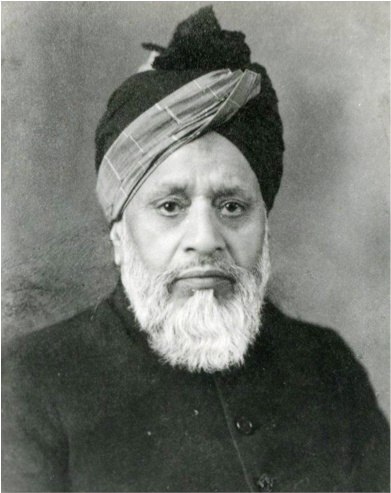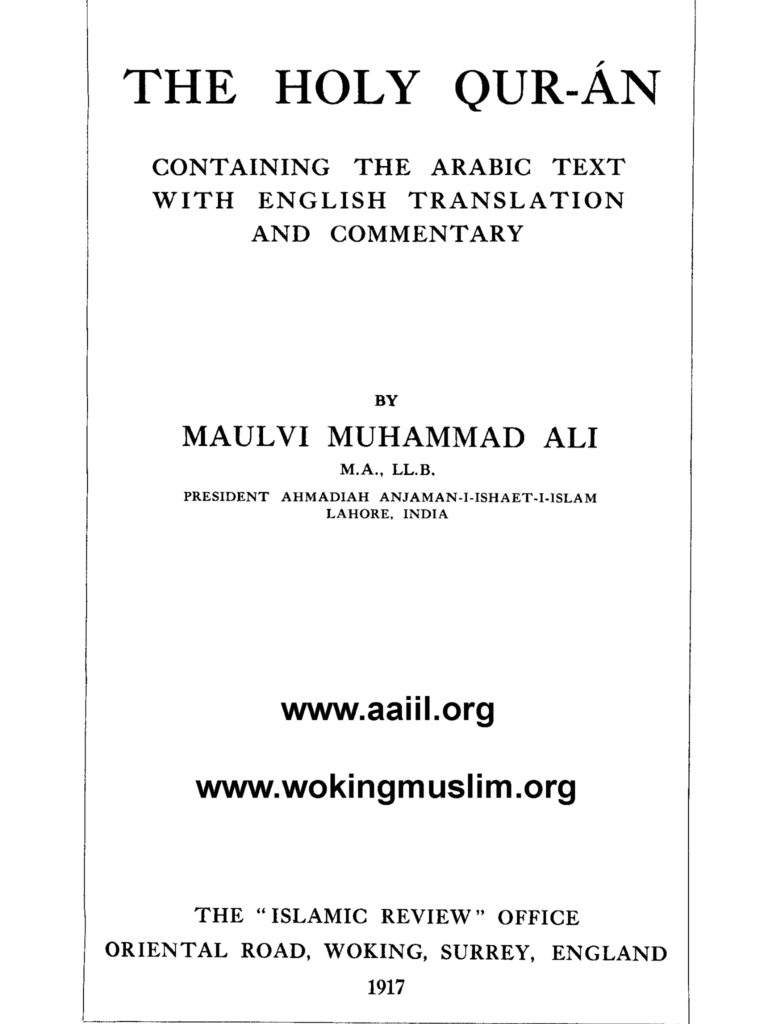This week we will look at Muhammad Ali’s influential English translation, entitled The Holy Qur-án, which was first published in 1917. Muhammad Ali (d. 1951) was a renowned Ahmadi scholar who was born in 1874 in Murar, in the state of Kapurthala in India. Ali studied mathematics, law and English at university, after which he went on to work in academia and, from 1896 to 1899, held a position as a lecturer in mathematics at Islamia College Lahore. It was during this time, in 1897, that he joined the Ahmadiyya movement, recognizing Mirza Ghulam Ahmad (d. 1908) as the Messiah and Mahdi.
Mirza Ghulam Ahmad had long wanted to publish an English Qur’an commentary: as early as 1890, a year after he founded the Ahmadiyya movement, he had expressed his desire to send an English commentary (tafsīr) on the Qur’an to Europe to be used for proselytizing purposes. This project, however, was not to be realized during his lifetime. It was not until 1909, a year after Mirza Ghulam Ahmad’s passing, that the idea of publishing an English translation took concrete shape when Muhammad Ali began translating the Qur’an with the help of Mawlawī Nūr al-Dīn (d. 1914), his mentor and the first successor (Khalīfa) of Mirza Ghulam Ahmad. The messianic aspirations of Mirza Ghulam Ahmad and the expectation of the rapid spread of Islam served as the primary driving force behind this endeavor.
However, six years after Ghulam Ahmad’s death, the movement was shaken by a dispute over his prophetic status, and this ultimately led to the division of the movement into two branches. One, the Qadian branch, was headed by Ghulam Ahmad’s son, while Muhammad Ali became the leader of the Lahore branch, better known as Ahmadiyya Anjuman Isha’at-e-Islam Lahore. Muhammad Ali relocated to Lahore, where the new headquarters of the Lahore Ahmadiyya was established. It was here that his translation of the Qur’an was finally completed, and it was printed in the United Kingdom in 1917 by the branch’s mission in Woking.
Muhammad Ali’s translation was tailored for an educated Western readership, and to English-speaking Muslim converts, and was intended to expedite missionary work in Europe. A major characteristic of Ali’s translation is that he divided the suras into subchapters and wrote an introduction that prefaced the translation of each sura. He also implemented the idea of placing the Arabic text and the English translation in parallel columns on the page, instead of the usual interlinear format, a layout that was later adopted by many other publishers. This first edition of Ali’s The Holy Qur-án was reprinted in 1920 and 1935. A monolingual edition with abbreviated notes also appeared in 1928. In 1951, Muhammad Ali published a revised edition of his translation.
Muhammad Ali’s translation promotes a rational interpretation of the Qur’an, one in which miracles and stories mentioned in the Qur’an are construed in a way that does not contradict natural law. This understanding affects the way that specific verses are translated, as is evident, for example, in the translation of the Arabic phrase ‘iḍrib bi-ʿaṣāka l-ḥajar’ in Q 2:60. Abdel Haleem translates this verse as follows:
‘Remember when Moses prayed for water for his people and We said to him, ‘Strike the rock with your staff.’’
Muhammad Ali, on the other hand, opted to translate it as:
‘And when Moses prayed for drink for his people, We said: Seek with your staff a way into the mountain.’
Muhammad Ali justifies his translation of this verse in a lengthy footnote, which includes quotation from various Arabic dictionaries. (It is also worth noting that his interpretation is strongly reminiscent of Sayyid Ahmad Khan’s Urdu translation published in 1880, in which he took a similar approach). Interestingly, in this particular instance, Muhammad Ali changed his mind in 1951 and opted for a literal translation of the passage in the revised edition of his translation.
In some other places Muhammad Ali does not alter the normative interpretation of the Arabic source text as he does for Q 2:60, but instead uses footnotes to provide a rational context, particularly in the case of prophetic stories. This is apparent, for example, in his rendition of the story of Abraham, who was thrown into the fire by his people after desecrating their idols (Q 21:68-70). Muhammad Ali notes in a footnote that ‘the fire was only a kaid, or a hard struggle, against him, or a war of opposition to him,’ thereby interpreting the account as metaphorical rather than literal.
Although the Ahmadiyya movement was (and still is) viewed critically in Muslim circles, Ali’s ‘rational’ translation sparked admiration, especially in educated circles drawn to Western education. Translators such as Ghulam Sarwar, Pickthall, and Yusuf Ali, were influenced by Muhammad Ali’s work, and praised his translation in the preface to their own renditions. Due to its canonical status for the Lahore Ahmadiyya, Muhammad Ali’s rendition was not only highly influential in the English-speaking world, but also served as a blueprint for many Ahmadi and non-Ahmadi Qur’an translators into other languages worldwide.
For example, some evidence of the reach of Ali’s translation can be gleaned from the history of Qur’an translation in Indonesia. In the 1920s, Oemar Syed Tjokroaminoto (d. 1934), the then head of Sarekat Islam, intended to compose a translation of the Qur’an in Malay. Tjokroaminoto planned to base his Malay Qur’an on Muhammad Ali’s translation, and this sparked an uproar in conservative circles, who regarded the teaching of the Ahmadiyya with contempt. The dispute over Tjokroaminoto’s translation was carried all the way to Egypt, where Rashid Rida issued a fatwa against the permissibility of Qur’an translations. After the dispute was settled Tjokroaminoto was eventually allowed to continue his work although, unfortunately, he never completed it (see QTOTW #87). As is clear from this example, Muhammad Ali’s translation was already known in Southeast Asia and Egypt in the 1920s, and inspired Muslim translators worldwide.
Muhammad Ali was not the first Muslim to translate the Quran into English, but his translation seems to be the first to be recognized and used internationally. This was at least partly due to the fact that, unlike earlier Muslim translators who produced English Qur’an translations, Muhammad Ali could rely on the transregional network of the Lahore Ahmadiyya to promote his rendition. It is, furthermore, hardly surprising that the Lahore branch used Muhammad Ali’s translation as the basis for its Qur’an translations into other languages, which were used to enhance its missionary work in different parts of the world: as well as being published in English Ali’s work was translated into Dutch, French, Javanese, Spanish and Indonesian.
Kamran Khan



